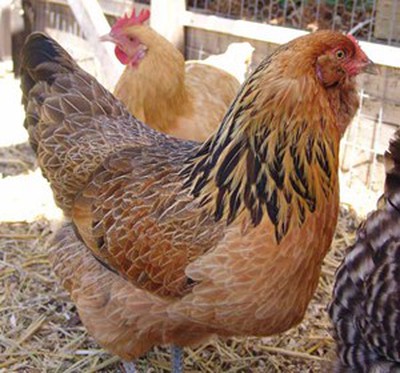Abstract
If you keep chickens (lucky you!), here's an interesting project you might want to try.Summary
Sources
This project is based on:- Palmer, II, T.H., 2004. Do Peanuts Make Chickens Lay Bigger Eggs?. California State Science Fair Abstract. Retrieved July 13, 2021.

Objective
The goal of this project is to determine whether feeding chickens a dietary supplement of peanuts will result in larger and heavier eggs. If peanuts do increase egg size, a secondary goal will be to determine the optimal amount of peanut supplement.Introduction
 Image Credit: Cynthia Boyd / Copyrighted, used with permission
Image Credit: Cynthia Boyd / Copyrighted, used with permission
In this project you'll investigate the effects of a hen's diet on egg production. The Experimental Procedure section presents a protocol for testing whether supplementing your hen's diets with peanuts will have an effect on the weight and size of the eggs they produce. Your background research may lead you to ask other questions about diet and egg production, but you can still use the procedure below as a starting point. The Variations section has additional ideas.
When a hen is laying, it takes about 24–26 hours to produce an egg (Nest Fresh, 2004). A typical chicken egg contains 7.2 g of protein, 6 g of fat, and 40 g of water (Cebra-Thomas, 2001).
The protein, fat, and water in the egg ultimately come from the hen's diet. Many commercial chicken feeds are available with different nutrient mixtures, optimized for stage of development, and for whether the chickens are being raised for eggs, meat, or both: "Different rations are often used, depending on the production stage of the bird. Starter rations are high in protein- an expensive feed ingredient. However, grower and finisher rations can be lower in protein since older birds require less. A starter diet is about 24% protein, grower diet 20% protein, and finisher diet 18% protein (1). Layer diets generally have about 16% protein." (Fanatico, 1998)
Find out about the nutritional composition of your hen's current diet. Also find out what nutrients peanuts offer. Do you think that adding peanuts to your hens' diets will have an effect on egg weight and size? Why or why not? Try it and find out!
Terms and Concepts
- Chicken ovulation
- Fat
- Carbohydrate
- Calcium
- Minerals
- Vitamins
- Trace elements
Questions
- What is the nutritional composition (nutrients and their relative amounts) in the normal diet of your flock?
- Approximately how much feed (by weight), does each of your hens consume daily?
- What are the dietary requirements of a laying hen?
- What is the nutritional content of eggs?
- What is the nutritional content of peanuts?
- How long does it take for a hen to produce an egg?
Bibliography
- Wabeck, C.J., (1995). Raising Your Home Chicken Flock. College of Agriculture and Natural Resources, University of Maryland. Retrieved August 9, 2006.
- Here is a highly recommended book on raising chickens:
Lutmann, R. and G. Lumann, 1976. Chickens in Your Backyard: A Beginner's Guide. Emmaus, PA: Rodale Press, Inc. - Fanatico, A., (1998). Feeding Chickens for Best Health and Performance. ThePoultrySite.com. Retrieved August 9, 2006.
- Cebra-Thomas, J., (2001). Overview of Chick Development. Developmental Biology Lab, Swarthmore College. Retrieved August 9, 2006.
- Nest Fresh, (2004). Frequently Asked Questions. Nest Fresh Organic Eggs. Retrieved August 9, 2006.
- This website has descriptions and calculators for several statistical tests, including the paired t-test that you can use in this project:
Kirkman, T., (n.d.). Student's t-Tests. Department of Physics, College of St. Benedict & St. John's University. Retrieved February 23, 2006.
Materials and Equipment
- Chickens
- Peanuts (unsalted, unshelled)
- Kitchen scale or other electronic pocket scale for weighing peanuts and eggs; available from online suppliers, such as Carolina Biological Supply Company
- Cloth tape measure (from sewing kit) for measuring circumference of eggs
Disclaimer: Science Buddies participates in affiliate programs with Home Science Tools, Amazon.com, Carolina Biological, and Jameco Electronics. Proceeds from the affiliate programs help support Science Buddies, a 501(c)(3) public charity, and keep our resources free for everyone. Our top priority is student learning. If you have any comments (positive or negative) related to purchases you've made for science projects from recommendations on our site, please let us know. Write to us at scibuddy@sciencebuddies.org.
Experimental Procedure
- Using information from your background research, decide how much peanut supplement (by weight) you want to provide daily for each hen. Choose reasonable amounts based on your experience and background research. For the following example, we will assume values of 5, 10, and 20% of the normal daily feed weight.
- There will be four different diets used in this experiment, each lasting for one week.
- control diet: normal daily "layer" feed only
- diet 1: normal daily "layer" feed + 5% peanut supplement
- diet 2: normal daily "layer" feed + 10% peanut supplement
- diet 3: normal daily "layer" feed + 20% peanut supplement
- Keep track of how much food, by weight, (both normal feed and peanut supplements) you put out each day, and how much is left uneaten. This way you'll be able to make a daily calculation of the average amount of feed and peanuts consumed by each hen. (If you wanted to be really precise, you'd have to separate the hens and feed them individually. This is probably not necessary.)
- Of course, you should also observe the hens and take note if any individuals seem to have a special preference for (or aversion to) peanuts. If this happens, you might want to remove such hens from the study (or separate the hens, as suggested above.)
- For each condition, measure the eggs produced.
- Keep track of which hen produced each egg.
- Record the weight of each egg.
- Record the circumference of the egg at its widest point, for both long and short axis.
- Here are some ideas for analyzing the results:
- From your feed and peanut weight measurements, did the hens continue to eat more peanuts as you increased the amount available? Did the amount of normal feed consumed increase, decrease, or stay the same as the amount of peanut supplement increased?
- From what you know about the composition of your normal feed and the composition of peanuts, how did the peanut supplement change the relative amounts of protein and fat in your hens' diets?
- Calculate the average and standard deviation for each egg size measurement for each hen. To allow time for the hens to digest and utilize the supplements for egg production, use measurements from the eggs produced on days 3–7 for each diet.
- Calculate the average and standard deviation for each egg size measurement for the entire flock. To allow time for the hens to digest and utilize the supplements for egg production, use measurements from the eggs produced on days 3–7 for each diet.
- Try other ways to calculate the average egg size for each diet. What happens if you include all 7 days in the average? What happens if you include only days 2–7? What happens if you include only days 4–7?
- More advanced students could use a paired Student's t-test to determine whether or not differences in average egg measurements resulting from different pairs of diets are statistically significant.
Ask an Expert
Global Connections
The United Nations Sustainable Development Goals (UNSDGs) are a blueprint to achieve a better and more sustainable future for all.
Variations
- Do you think you would get the same results if you scrambled the order of the diets? For example, what if you used the following schedule:
If you have more time, extend the study to eight weeks (or longer), and use a randomized sequence for the diets.
Week 1 diet 2 Week 2 control diet Week 3 diet 3 Week 4 diet 1 - Your mom and dad probably tell you about the importance of eating a varied and balanced diet. You can buy chicken feed specially formulated to provide all the nutrients for your layers. Will you get more eggs or larger eggs if you supplement your hen's diet with a variety of other foods they like (e.g., fresh greens, bits of fruit, bugs, etc.)? Do the chickens eat more, less, or the same amount of their usual feed when they are offered varied supplements to their diet?
- From your background research, you may have noticed one or more nutrients that may be in short supply in your flock's normal diet. Can you find one or more food supplements to address this? Is there an effect on egg size? Is there an effect on the number of eggs laid?
- Size is one thing, but how about measuring the nutritional content of eggs produced by chickens with different diets or living conditions? According to the (Mother Earth News Chicken and Egg webpage), eggs from their flocks of free-range chickens are more nutritious than typical supermarket eggs (per USDA nutrient database).
- Some chickens are raised for their meat. What are the special dietary requirements for these chickens? How do they differ from chickens that are laying? Design an experiment to test a diet which you think will help chickens grow faster.
- This Science Buddies project shows you how to measure the amount of energy in peanuts with a homemade calorimeter: Burning Calories: How Much Energy is Stored in Different Types of Food?
Careers
If you like this project, you might enjoy exploring these related careers:










